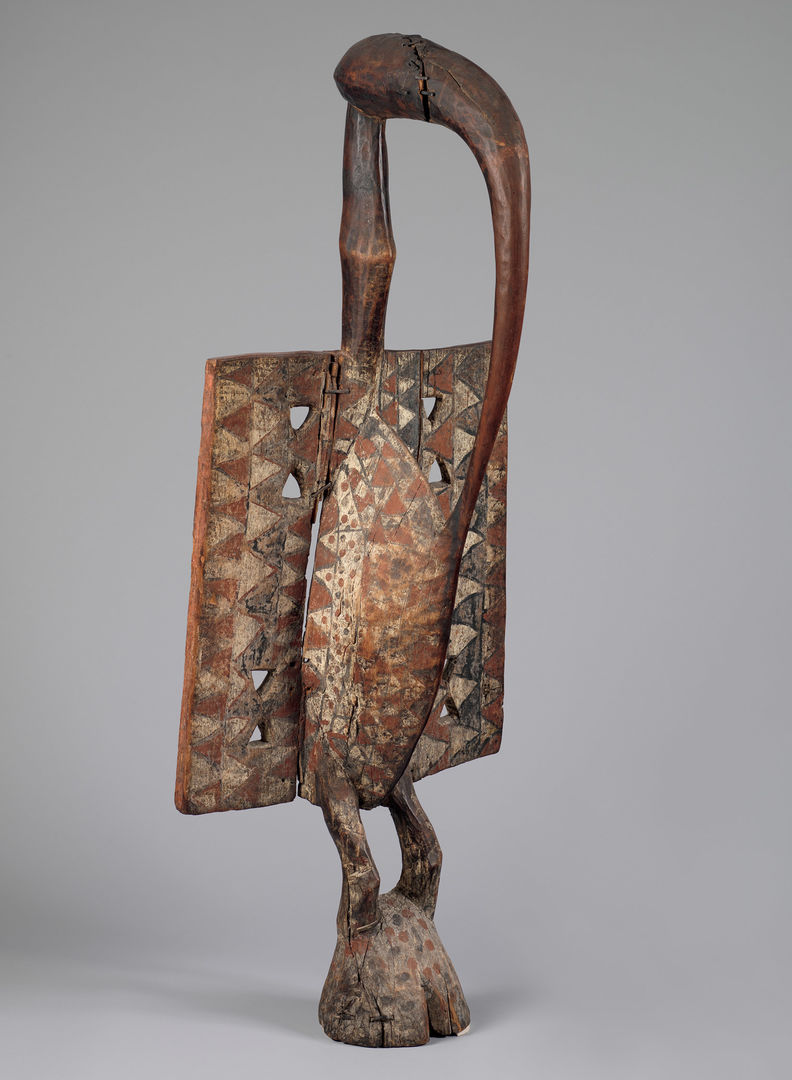A Rite of Passage

Bird (Sejen), 19th–mid-20th century. Côte d'Ivoire, northern Côte d'Ivoire. Senufo peoples. Wood, pigment; 59 5/8 x 23 1/2 x 14 1/4 in. (151.5 x 59.7 x 36.2 cm). The Metropolitan Museum of Art, New York, The Michael C. Rockefeller Memorial Collection, Bequest of Nelson A. Rockefeller, 1979 (1979.206.176)
Collection Area: African Art
Subject Areas: English Language Arts, Visual Arts, World History
Grades: Middle School, High School
Topics/Themes: Art and Writing, Art as a Primary Resource, Artist Choices, Identity
Goals
Students will be able to:
- make inferences supported by visual evidence;
- identify the function of this work in its original context; and
- recognize the ways in which objects play a key role in rituals and ceremonies in communities around the world.
National Learning Standards
English Language Arts
NL-ENG.K-12.4 Communication Skills
NL-ENG.K-12.9 Multicultural Understanding
Visual Arts
NA-VA.K-12.3 Choosing and Evaluating a Range of Subject Matter, Symbols, and Ideas
NA-VA.K-12.4 Understanding the Visual Arts in Relation to History and Cultures
NA-VA.K-12.6 Making Connections between Visual Arts and Other Disciplines
World History
NSS-WH.5-12.7 Era 7: An Age of Revolutions, 1750–1914
NSS-WH.5-12.8 Era 8: A Half-Century of Crisis and Achievement, 1900–1945
Common Core State Standards
English Language Arts
CCSS.ELA-Literacy.CCRA.R.1 Read closely to determine what the text says explicitly and to make logical inferences from it; cite specific textual evidence when writing or speaking to support conclusions drawn from the text.*
CCSS.ELA-Literacy.CCRA.R.6 Assess how point of view or purpose shapes the content and style of a text.*
CCSS.ELA-Literacy.CCRA.R.7 Integrate and evaluate content presented in diverse media and formats, including visually and quantitatively, as well as in words.
CCSS.ELA-Literacy.CCRA.W.3 Write narratives to develop real or imagined experiences or events using effective technique, well-chosen details, and well-structured event sequences.
*Art as text
Questions for Viewing
- Compare this sculpture with another similar bird (sejen). What are some similarities you notice? These works of art, made by artists from one of the Senufo communities of northern Côte d'Ivoire (in West Africa), are associated with Poro, a society that Senufo males join through an initiation process, which includes participation in activities, ceremonies, and rites of passage designed to teach social, moral, religious, and intellectual lessons.
- Bird sculptures like this are designed to protect the young as they go through these rites of passage. What are some ways the artist visually conveys the sculpture's protective role? [Note: The decoration on sculptures such as this likely serves as a teaching tool, reminding initiates of the wealth of knowledge preserved by the Poro society. As this knowledge is inaccessible to noninitiates, we know little about its meaning.]
- The long beak in this sculpture resembles that of a yellow-casqued hornbill, one of the species found in the Senufo area. The Senufo peoples consider it the master among birds and a symbol of intellectual power. Its yellow, "capped" head is equated with the red caps worn by Poro elders, who, like the bird, embody wisdom and authority. What, if any, animals in your community act as symbols (i.e., dogs are sometimes associated with loyalty)? What does the animal symbolize? Why?
Activity
Activity Setting: Classroom
Materials: Paper and pencil
Subject Areas: English Language Arts, Visual Arts, World History
Duration: Approximately 60 minutes
Choose an experience from your life that could be described as a ritual, ceremony, tradition, or rite of passage. Write a narrative describing the experience and a key role an object played in the event.
Resources
"Bird (Sejen) [Côte d'Ivoire; Senufo]." In Heilbrunn Timeline of Art History. New York: The Metropolitan Museum of Art, 2000–. (January 2010)
Clarke, Christa. The Art of Africa: A Resource for Educators. New York: The Metropolitan Museum of Art, 2006. Download the resource (PDF).
Explore the African Art Galleries: Secret Wisdom. Family guide. New York: The Metropolitan Museum of Art, 2013. Download the guide (PDF).
Gagliardi, Susan Elizabeth. "Senufo Sculpture from West Africa: An influential exhibition at The Museum of Primitive Art, New York, 1963." In Heilbrunn Timeline of Art History. New York: The Metropolitan Museum of Art, 2000–. (January 2010)
Gagliardi, Susan Elizabeth. "Senufo Arts and Poro Initiation in Northern Côte d'Ivoire." In Heilbrunn Timeline of Art History. New York: The Metropolitan Museum of Art, 2000–. (January 2010)
School Group Self-Guide: The Art of Africa. Download the guide (PDF).
Roberts, Allen F. Animals in African Art: From the Familiar to the Marvelous. New York: The Museum for African Art, 1995.
Objects in the Museum's Collection Related to this Lesson
Bird (Sejen), 19th–mid-20th century. Côte d'Ivoire, northern Côte d'Ivoire. Senufo peoples. Wood; 47 11/16 x 18 x 15 in. (121.2 x 45.7 x 38.1 cm). The Metropolitan Museum of Art, New York, The Michael C. Rockefeller Memorial Collection, Gift of Nelson A. Rockefeller, 1964 (1978.412.382)
Bird (Sejen), 19th–mid-20th century. Côte d'Ivoire, northern Côte d'Ivoire. Senufo peoples. Wood, pigment; 25 15/16 x 12 3/4 x 7 1/2 in. (66 x 32.4 x 19.1 cm). The Metropolitan Museum of Art, New York, The Michael C. Rockefeller Memorial Collection, Gift of Mrs. Gertrud A. Mellon, 1963 (1978.412.484)
Bird (Sejen), 19th–mid-20th century. Côte d'Ivoire, northern Côte d'Ivoire. Senufo peoples. Wood, iron, twine; 55 11/16 x 24 1/4 x 15 in. (141.5 x 61.6 x 38.1 cm). The Metropolitan Museum of Art, New York, The Michael C. Rockefeller Memorial Collection, Bequest of Nelson A. Rockefeller, 1979 (1979.206.165)
Author: Adapted from a lesson by classroom teacher Marylyn Christie, Sacred Heart Grade School, 2011